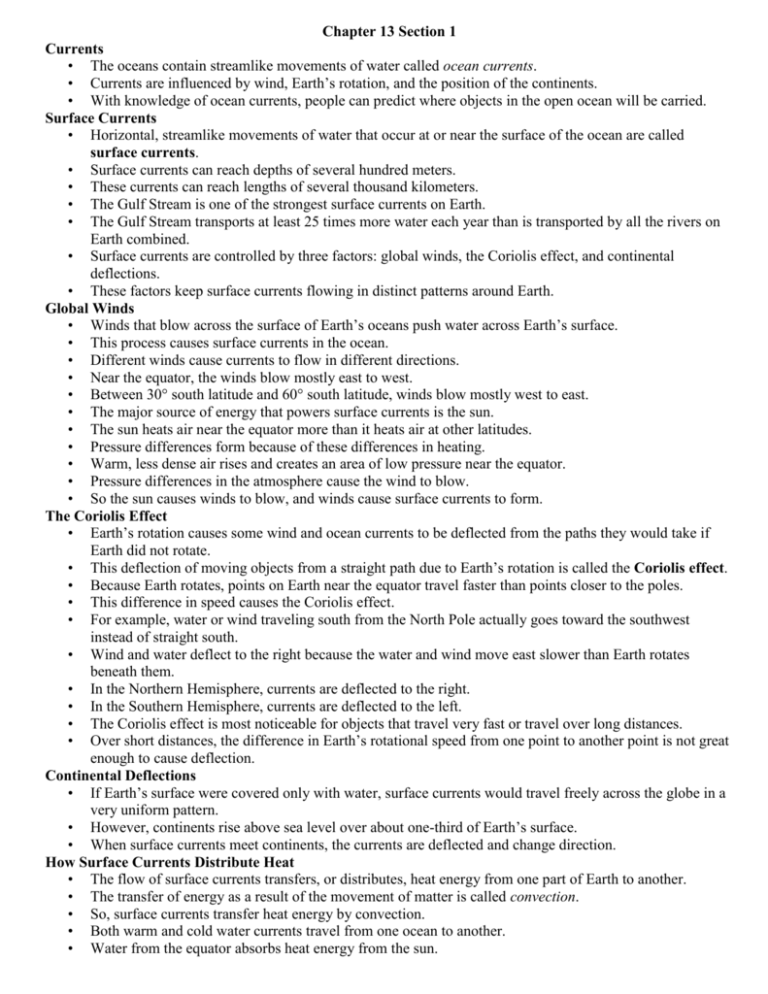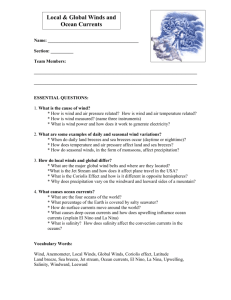Chapter 13 Section 1
advertisement

Chapter 13 Section 1 Currents • The oceans contain streamlike movements of water called ocean currents. • Currents are influenced by wind, Earth’s rotation, and the position of the continents. • With knowledge of ocean currents, people can predict where objects in the open ocean will be carried. Surface Currents • Horizontal, streamlike movements of water that occur at or near the surface of the ocean are called surface currents. • Surface currents can reach depths of several hundred meters. • These currents can reach lengths of several thousand kilometers. • The Gulf Stream is one of the strongest surface currents on Earth. • The Gulf Stream transports at least 25 times more water each year than is transported by all the rivers on Earth combined. • Surface currents are controlled by three factors: global winds, the Coriolis effect, and continental deflections. • These factors keep surface currents flowing in distinct patterns around Earth. Global Winds • Winds that blow across the surface of Earth’s oceans push water across Earth’s surface. • This process causes surface currents in the ocean. • Different winds cause currents to flow in different directions. • Near the equator, the winds blow mostly east to west. • Between 30° south latitude and 60° south latitude, winds blow mostly west to east. • The major source of energy that powers surface currents is the sun. • The sun heats air near the equator more than it heats air at other latitudes. • Pressure differences form because of these differences in heating. • Warm, less dense air rises and creates an area of low pressure near the equator. • Pressure differences in the atmosphere cause the wind to blow. • So the sun causes winds to blow, and winds cause surface currents to form. The Coriolis Effect • Earth’s rotation causes some wind and ocean currents to be deflected from the paths they would take if Earth did not rotate. • This deflection of moving objects from a straight path due to Earth’s rotation is called the Coriolis effect. • Because Earth rotates, points on Earth near the equator travel faster than points closer to the poles. • This difference in speed causes the Coriolis effect. • For example, water or wind traveling south from the North Pole actually goes toward the southwest instead of straight south. • Wind and water deflect to the right because the water and wind move east slower than Earth rotates beneath them. • In the Northern Hemisphere, currents are deflected to the right. • In the Southern Hemisphere, currents are deflected to the left. • The Coriolis effect is most noticeable for objects that travel very fast or travel over long distances. • Over short distances, the difference in Earth’s rotational speed from one point to another point is not great enough to cause deflection. Continental Deflections • If Earth’s surface were covered only with water, surface currents would travel freely across the globe in a very uniform pattern. • However, continents rise above sea level over about one-third of Earth’s surface. • When surface currents meet continents, the currents are deflected and change direction. How Surface Currents Distribute Heat • The flow of surface currents transfers, or distributes, heat energy from one part of Earth to another. • The transfer of energy as a result of the movement of matter is called convection. • So, surface currents transfer heat energy by convection. • Both warm and cold water currents travel from one ocean to another. • Water from the equator absorbs heat energy from the sun. • Then, warm-water currents carry the energy from the equator to other parts of the ocean. • The heat energy from the warm water is transferred to colder water or to the atmosphere. • Cold-water currents absorb heat energy from the atmosphere and from other ocean currents. Deep Currents • Movements of ocean water far below the surface are called deep currents. • Unlike surface currents, deep currents are not controlled by wind. • Instead, the movement of deep currents is caused by differences in water density. • Water that flows deep in the ocean is denser than water at the ocean surface. • Density is the amount of matter in a give space or volume. • The density of ocean water is affected by salinity and temperature. • Salinity is the measure of the amount of dissolved salts or solids in a liquid. • Water with high salinity is denser than water with low salinity. • Cold water is denser than warm water. How Deep Currents Form • The density of ocean water can be increased by decreasing temperature, increasing salinity through freezing, or increasing salinity through evaporation. • In these three ways, ocean water at the surface can become denser than water below it. • When denser water sinks, the downward movement takes water from the surface to the deep ocean. • Deep currents flow below the surface. • These currents are made of dense water that flows along the ocean floor or along the top of a layer of denser water. • Because the ocean is so deep, there are several layers of water at any location in the ocean. • The deepest and densest water in the ocean is Antarctic Bottom Water, which forms near Antarctica. • North Atlantic Deep Water is less dense and forms in the North Atlantic Ocean. • Less-dense water always stays on top of denser water. • So the North Atlantic Deep Water flows on top of the Antarctic Bottom Water when the two meet. Convection Currents • Surface currents and deep currents are linked in the ocean. • Together, they are called convection currents because their movement results partly from differences in water density. • Convection currents transfer energy as they flow. • Warm water at the ocean surface absorbs energy from the sun. • Surface currents carry this energy to colder regions. • The warm water loses energy to its surroundings and becomes cooler. • As the water cools, it becomes denser and sinks. The cold water travels along the ocean bottom. • Then, the deep water rises to the surface as surface water moves away. • The cold water warms as it absorbs energy from the sun, and the cycle continues. Global Circulation • Ocean water circulates through all of Earth’s ocean basins. • These paths are like a main highway on which much ocean water flows. • A water molecule following these paths would take 1,000 years to come back to its starting point. • Global ocean circulation moves materials as well as water. • Two of the most important materials transported this way are oxygen and nutrients. • Oxygen is taken from the surface to the deep ocean by deep currents. • Nutrients are brought to the surface as deep water rises. • Global ocean circulation is also very important in the distribution of heat. • About half the heat that is transported around Earth’s surface is carried by convection currents in oceans. • Thus, ocean circulation is important in global climate regulation.








